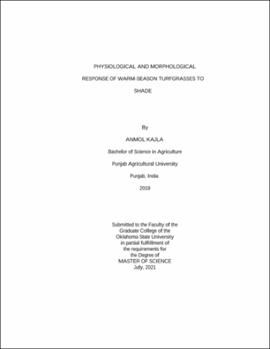| dc.description.abstract | Shade affects turfgrass growth and development, lowering the quality and playability of sporting fields and golf courses. The desire for large mature trees in the landscape and modern sports stadiums, are expected to increase the frequency and severity of shade in managed turf, implying that increased selection and use of shade resistant grasses is required to improve the turf industry's sustainability. In both field and controlled environment investigations, species and cultivars within species showed heterogeneity for relative shade resistance, but little is known about the mechanisms that impart resistance. Greenhouse studies were conducted at Stillwater, Oklahoma to compare the physiological and morphological response of two species of warm-season grasses varying in their apparent shade resistance. Four genotypes of each species were evaluated on the basis of their photosynthetic and growth parameters. Amongst bermudagrasses (Cynodon dactylon x C. transvaalensis), shade resistant TifB16108 had lower dark respiration rate, light saturation estimate at 75th percentile (Isat75), and light compensation point (Icomp) while having higher Fv/Fm and root:shoot ratio as compared to shade sensitive genotypes 'Tifway' and TifB16119. Amongst St. Augustinegrasses (Stenotaphrum secundatum) shade resistant DALSA 1404 and DALSA 1618 had lower Icomp, Isat75, root: shoot ratio, and high percent green cover, while shade sensitive 'TamStar' performed poorly under shade. Grasses evaluated for their morphological parameters showed a higher leaf area index (LAI), leaf weight ratio (LWR), and maintained root: shoot biomass for the genotypes showing resistance to shade. 'ST-5' (TifGrand) had the highest LAI, Specific leaf area, LWR, leaf area ratio, amongst the other bermudagrasses, which suggests leafiness contributes to its shade resistance. Amongst the St. Augustinegrasses, DALSA 1618 and 1329 maintained the lowest canopy elongation rates and highest LAI, SLA, and LWR. But no single parameter or factor could be defined as the tool for predicting sensitivity to shade as it is the aggregation of various adaptive features that impart resistance to shade. Resistance of a genotype was dependent on both physiological tolerance and morphological adaptation to shade but was better explained by their changes in physiology which affected its overall performance. | |
